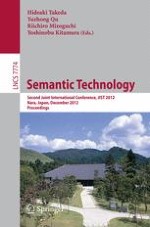This book constitutes the proceedings of the Second Joint International Semantic Technology Conference, JIST 2012, held in Nara, Japan, in December 2012. The 20 full papers and 13 short papers included in this volume were carefully reviewed and selected from 90 submissions. The regular papers deal with ontology and description logics; RDF and SPARQL; learning and discovery; semantic search; knowledge building; semantic Web application. The in-use track papers cover topics on social semantic Web and semantic search; and the special track papers have linked data in practice and database integration as a topic.
